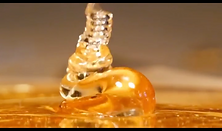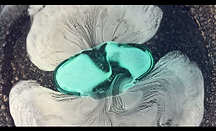
DESIGNING NATURE
Video component for "Designing Nature."
Designing Nature
"Designing Nature" is a mock exhibition curated by Chicago’s Academy of Design and Practice. In the distant future, there will be no existent remnant of the natural world. So far removed from such a time, those living on what is left of earth have no tangible connection to nature, not even in memory. While the exhibition excels in its aesthetics, it appeals more to art and experience than to history or an appreciation of nature.
This project’s components consist of an audial visual projection, acrylic screen prints, and vinyl lettered labels. Its main piece, a projected sensory exploration into naturally occurring environments, is riddled with misinformation and muddied by the human touch. Shots of rolling landscapes are interrupted by dissolving pills and landfills. A harmony of crickets morphs into synth noises without meaning. The ambiguity of each element makes it difficult to differentiate pure nature from human influence and shows the interdependence between humanity and nature.

Photograph by the Living Energy Learning Center.

"Designing Nature" in exhibition at Chicago's Lost Arts in 2018. Photograph by Nate Matteson.
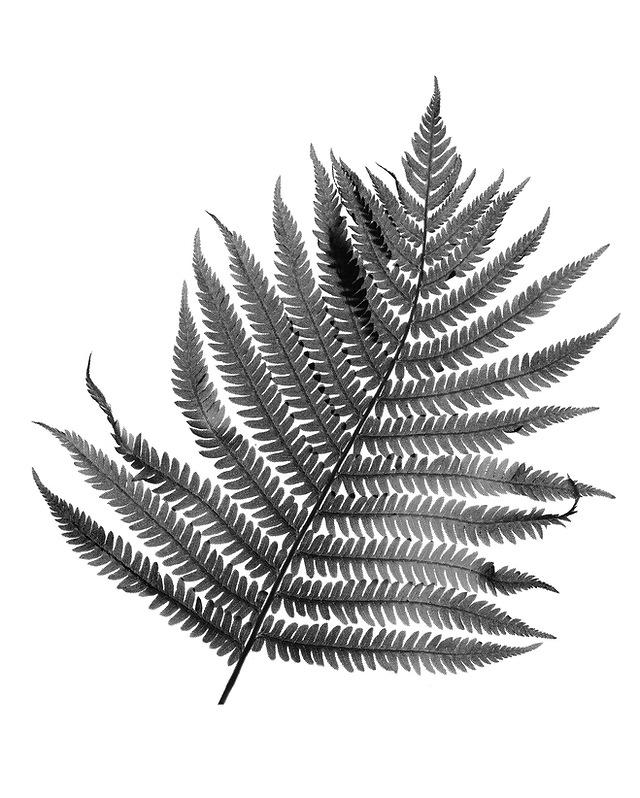
A fern, plucked from a Lincoln Park garden, scanned, and converted to halftone.
The screen printed acrylic pieces depict images of x-rayed flora. An impression of an impression, the prints represent the derivate relationship between the earth and its people. While the prints illustrate design forms in nature, their medium will relay a sense of ambiguity and intangibility that fits with the minimalist aesthetic of the installation as a whole. Finally, these pieces are accompanied by vinyl cut lettering that serves as labeling and an artist’s statement for the exhibition. The rhetoric is just as ambiguous as the visual and audial elements of the installation and serves as more of an aesthetic choice than one with meaning.
The installation, outside of its role as a mock exhibition, acts as a commentary on humanity’s relationship with nature. It aims to critique society’s views on art and history and question whether these studies can be truly objective. The project is motivated by the relationship between nature and humanity, as society simultaneously destroys and takes inspiration from the earth. Its aim is to bring attention to this dynamic and encourage further introspection on one’s responsibility in preserving our environment. With exposure to a misguided version of nature in its “truest form,” one can see how humanity has tremendously affected this planet.
Because “Designing Nature” is an exhibition within an experimental design project, it has two separate audiences. In the world of this dystopian, unnatural future, the Academy appeals to a broad audience—one that takes more interest in the social marketability of an experience rather than the historical or natural content of said experience. The exhibit as a design concept has a more engaged audience. These viewers will recognize the irony in designing nature and feel motivation to take active roles in preserving what is left of nature.


Initial Research
Photograph by National Geographic.
“You need to visit the Great Barrier Reef because in twenty years, I guarantee it will be gone.”
After one of his many excursions to the fragile coral reefs, my uncle implored me to dive as he had, seeing the natural wonders that will undoubtedly cease to exist by the time I have grandchildren. He’s a smart man and an environmental activist, but I couldn’t help but see the irony in his statement. My going to the Great Barrier Reef would only harm it further; is my longing to see a dying natural wonder worth expediting its demise? What right have I to see its beauty?
How do our visits affect their destinations? How do our everyday actions affect places we have never seen? When it comes down to it, whether you have visited coral reefs or not, you—and every individual on this planet—affects all parts of the world. Our products consumed and trash created are all part of an intricate and interconnected web that includes the earth and its inhabitants. What responsibility do we have in the consequences of our actions? Can we truly love or experience something without leaving a fingerprint? In delving into these questions, I became interested in the relationship between nature and humanity.
My initial research focused on ecotourism and the potential irony in its practice. Ecotourism has a slew of debated definitions, but at its core, it promotes tourism with consideration to environmental and cultural repercussions of travel and encourages tourist participation in community activism. However, advocating even conscious travel to endangered destinations may cause issues. Martha Honey, author of Ecotourism and Sustainable Development notes, “At its worst, when not practiced with the utmost care, ecotourism threatens the very ecosystems on which it depends. At its best, ecotourism offers a set of principles and practices that have the potential to fundamentally transform the way the tourism industry operates.” Inspired by the irony behind ecotourism, I shifted gears.
I wanted to create something that demonstrated the harmful effects of modern culture on our natural environment, but did so in a subversive and almost innocent manner. Often, we take the work of professionals as absolute truth—in textbooks, museums, research, and literature. If a reputable museum can make errors in documenting the harsh reality of our dependent and destructive relationship with nature, we as individuals may see that we are all guilty of unknowing harm.
Moving forward, I did extensive research in audio and visuals, searching for footage that depicted nature, humanity, and ambiguous in-betweens. Later in the book, I detail every source referenced in my work and how each one was pieced into the whole of this project.
World-building the Future
The world that conceived “Designing Nature” is fiction, fabricated from the impossibility of life without natural influence. Without vegetation, we would have no air to breathe and no food to eat. Humans cannot survive without nature. Without nature, there would be
no future.
For the purposes of this project, however, I have constructed a thought experiment in which humans
have survived past their destruction of the natural world. Inhabitants of the earth avoid the barren wasteland of the outdoors, spending their time exclusively within the safety of environmentally regulated buildings. Nutrition lies in the hands of chemistry and is consumed in raw, flavorless forms. Socially, humans are even more concerned with the goings on of their peers. Without material distractions, humanity has fully embraced its digital lifestyle. Art and entertainment maintains minimalist taste and intangible products.
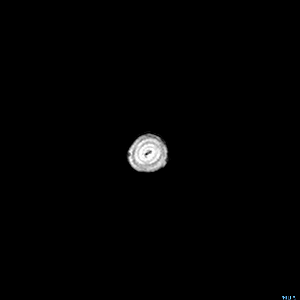
A magnetic resonance imaging of a banana flower by Andy Ellison.

The Academy of Design and Practice is the institutional home for “Designing Nature” as a fabricated exhibit. It follows the architectural structure of a modern museum, but does not limit itself with chosen content. While it is seen as a reputable institution of the future, it is not fully accurate in its depiction of “truth.” The museum’s logo was inspired by those of the Victoria and Albert Museum and the Museum of Contemporary Art Chicago. The following show some of the process of creating the logo and a final deliverable.



Logos for V&A Museum and MCA Chicago.
Preliminary iterations of the Academy of Design and Practice's logo.

A final version of the museum's primary branding with text set in Mostra Nuova by Mark Simonson.

The suspended screen prints are inspired by Dr. Dain L. Tasker’s series of x-rayed flowers he created in the 1930s. An assortment of flora and fauna were scanned as photo negatives, digitally converted to halftone patterns, and exposed onto screens to print. The choice of plexiglass as a medium conveys the sterility and lack of color in a future without nature. The flattened imagery on clear acrylic harkens back to plates and slides studied under microscopes, further illustrating the relationship between humanity and nature.
Final Components
A halftone conversion of Dr. Tasker's "Fuchsia."
Radim Schreiber’s “Firefly Experience” (2016); Andy Ellison’s “Inside Insides: Magnetic Resonance Imaging of Foods” (2015); Nature Relaxation Films’ “8HR 4K Aurora Borealis...” (2018); BBC Earth Un- plugged’s “10 Hours Of Relaxing Jungle Sounds...” (2017).
The short projection is a collection of footage sourced from an array of documentaries, nature photography, and found cinema. While the future museum’s mission is to create an accurate depiction of untouched nature, humanity bleeds into aspects of this visual component of the exhibit. In the context of this project, each shot is ambiguous and purposely difficult in differentiating pure nature from its human counterpart.





AlteredStates’ “Fireworks filmed with a drone” (2014); Planet Ocean, directed by Yann Arthus-Bertrand and Michael Pitiot (2012); BBC Earth Unplugged’s “10 Hours Of Relaxing Planet Earth II Desert Sounds...” (2017); “Honey ‘Tornado,’” posted to Imgur by thund3rbolt (2018).
Planet Ocean, directed by Yann Arthus-Bertrand and Michael Pitiot (2012); Macro Room’s “Pills Dissolve in Macro” (2016); Human VOL. 2, directed by Yann Arthus-Bertrand (2015); Human VOL. 1, directed by Yann Arthus-Bertrand (2015).
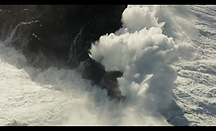
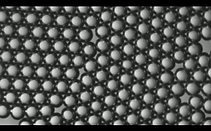


Human VOL. 2, directed by Yann Arthus-Bertrand (2015); Jeff Quitney’s “Physics: Crys- tals 1958 Alan Holden - Bell Laboratories...” (2016); Aurel Manea’s “Blood on 1000x Microscope...” (2011); Human VOL. 2, directed by Yann Arthus-Bertrand (2015).
Audio files sourced from: Julie Freeman’s “The Lake;” “We Need Us,” commissioned by The Space and the Open Data Institute (2014); The National Oceanic and Atmospheric Administration’s “PMEL Acoustics;” BBC’s Planet Earth II.

The authentic quality of “Designing Nature” as an exhibition depends on its labels. Without an artist’s statement or explanatory labels, art depends on the perspectives of its viewers. In a future without nature, the world’s inhabitants live in a world of screens and plastics. Art is enjoyed for its social economy and ability to be shared. Museum-goers of the future do not seek meaning. Any attempt to portray thought or expression must be done outwardly so, and even then, it still seems to escape most of its audience.
This work was designed by Julie Ivers for DePaul University’s Graphic Design Capstone in 2018. It was exhibited at Lost Arts in Chicago. The original process publication was printed by Josh Miller and typeset in Mostra Nuova by Mark Simonson and Avenir by Adrian Frutige. The web version is set in Avenir and Brandon Grotesque by Hannes von Döhren.
This project would not have been possible without the help of Nate Matteson, Shiro Akiyoshi, Jessica Larva, Matt Quinn, and the love and support of Julie's parents and friends.





